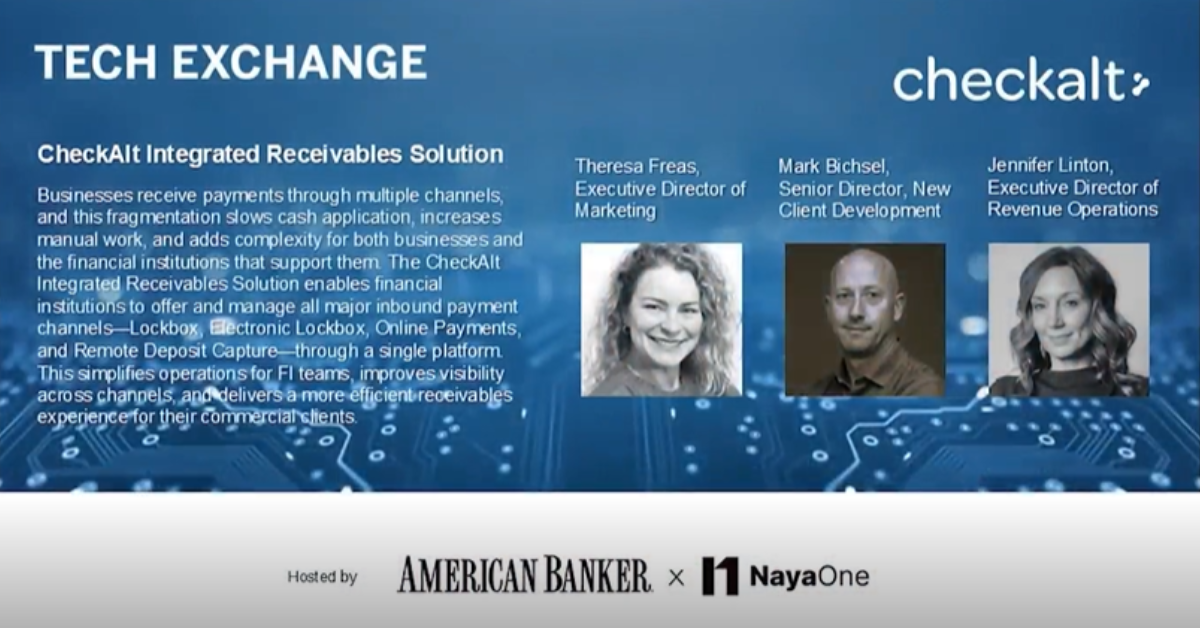Modern Receivables, Simplified: Why Financial Institutions Are Turning to an Integrated Approach
Receivables are becoming harder to manage across separate systems. See how an integrated approach brings those channels together for a modern...
3 min read
The financial services industry is increasingly having to grapple with the new normal: a rapidly changing technology landscape and commercial client behavior.
Today only very large institutions have the resources to meet the demand, especially in a rapid and frequent manner – so how can community banks and credit unions compete in such an evolving competitive landscape?
It all comes down to a commitment from the top down and finding the resources to engage in a successful way. That can be easier said than done, though, as community banks and credit unions also have to contend with their own institution’s version of the Four Horsemen of the Apocalypse — operations, compliance, IT and sales. Not to say they are in and of themselves a roadblock, but they are likely overburdened and lacking in the needed capacity to work with a multitude of new vendors and solutions.
But if financial institutions partner with FinTech in the right way, the payoffs can be worth it: banks can grow low-cost deposits, deepen existing account relationships, accelerate customer acquisitions, and provide many more “sticky” offerings and new sources of non-interest fee income.
As a result, community banks and credit unions can gain a competitive edge against other players -- both within and outside the industry – by being quick to meet new market demands as they arise, and being the one-stop- shop for their customers.
There are several ways a financial institution can partner with FinTech. They can choose the standard approach and work with one FinTech vendor at a time, which typically entails providing a single, specific product to meet one or a few customer needs at one time.
The pros of this approach is that it is familiar and comfortable to the institution, and the partnership is easier to manage. Moreover, the vendor’s solution typically meets an immediate need, there is typically lower capital outlay, and institutions typically have the ability to customize or offer an exclusive solution.
But on the flip side, such solutions typically solve only one need and institutions must be able to commit to the single solution – and they must also use internal resources to determine whether the vendor’s solution can be adequately integrated into their existing systems. This approach also requires that institutions take the time to conduct due diligence on the vendor, which is becoming more difficult today even for their existing ones.
Institutions can also choose the multi-solution vendor route, and contract with a vendor that can provide solutions based on a business line. This typically means working the institution’s core provider.
The advantages of this approach is that it meets more than one need and the solutions are usually integrated, sometimes with the same look and feel. Vendor management is also easier, and sometimes the institutions get discounts for providing certain solutions.
However, many of the solutions provided are not always “best of breed” and there is little customization for the resource-intensive solutions. Moreover, vendors are slow to upgrade their solutions, leaving institutions stuck in long-term contracts while their competitors adopt newer, better solutions.
Institutions can also opt for a third-party consultative relationship, and engage with a firm that can provide a strategic, long-term set of solutions as well as services from many technology providers.
The pros of working with such a firm are that it’s a one-stop-shop that offers many solutions, which can minimize pressure on resources. Such an approach is more strategic, as the relationship can evolve with changing needs, making it more of a long-term play.
However, this approach is often more unfamiliar to institutions and that strategy may be hard to define. There is also more of a reliance on a third party, and consulting not always viewed positively.
To determine which approach makes the most sense, institutions should follow this checklist: determine whether the FinTech vendor has the appropriate industry experience, qualified staff and resources, and one that actually understands banking. Institutions should make sure they have a complete and annually updated due diligence package, including documents such as audited financials, a SSAE16/SOC report, DR testing, penetration testing, insurance certificates, etc.
Ideally, the vendor should be able to provide broad array of solutions that are core/IP agnostic, and can provide ongoing support. The vendor must always be performance-focused, always be willing to listen and respond to institutions’ needs, and whose implementation and project management teams are creative and adaptive. Overall, the vendor should have a holistic approach and a clear view of the market.
A truly holistic FinTech partner will help define, enable and ensure success. Having a holistic approach is one that makes agility the norm, a feat that is increasingly becoming critical.
The new normal is centered on changing needs and behaviors, and while fear leads to inaction and loss, banks CAN profit from the new normal in many ways. A clear strategy and defined goals are the first step, and commitment from the board, senior management and staff is key.
Existing gaps in bank resources must be identified and filled, and measuring results regularly and adjusting along the way is needed. Institutions must also remain open minded, educated and willing to see change as good.

Receivables are becoming harder to manage across separate systems. See how an integrated approach brings those channels together for a modern...

The Top 5 Most-Read Articles of the Year 2025 offered clear insight into what our audiences valued most: practical AI adoption, stronger fraud...

With Gen Z gaining financial independence, banks and credit unions face a generational inflection point. These digital natives—born between 1996 and...